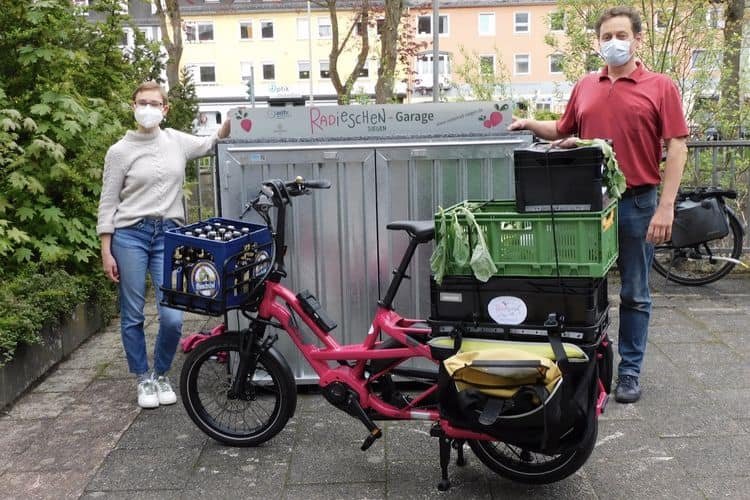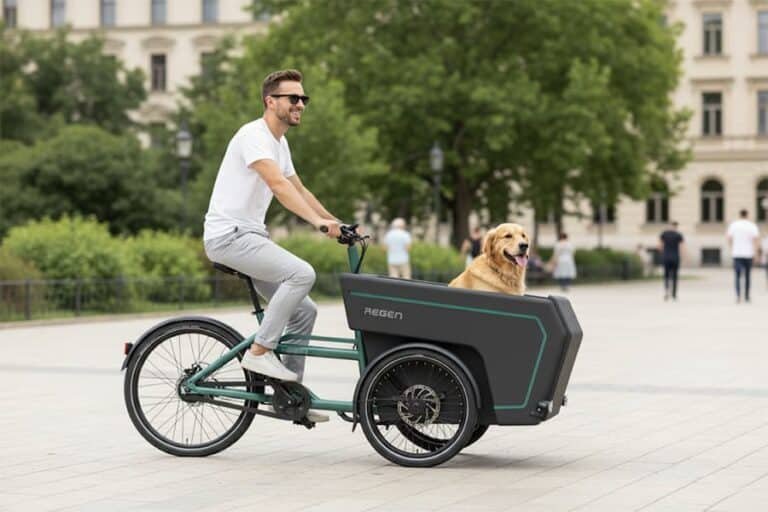この記事の中で Regen の両方を網羅し、コンシューマーおよびファミリーユースのカーゴe-bikeの認証の迷路を案内する。 必須規制証明書 そして 自主安全基準 メーカーが(そして精通した消費者が)注目するものである。その過程で、以下の規制の状況を比較する。 ヨーロッパとアメリカなどの主要な認証を強調している。 CEマーキング, EN 15194, UL 2849などなど。私の目標は、各認定が何を意味するのか、なぜそれが重要なのか、ルールを形成する最近の傾向を説明することです。さっそく始めよう!
E-Bike認証の現状を理解する
具体的なラベルや数字について説明する前に、e-bikeの文脈における「認証」の意味を明らかにしよう。大きく分けて、2つのカテゴリーがある:
- 必須の規制認証: これらは、ある地域の法律で義務付けられている。メーカーがその市場でe-bikeを販売したい場合、そのe-bikeは、その地域の法律で義務付けられている。 マスト を遵守すること。例えば、欧州におけるCEマーキングや、米国における特定の連邦安全要件などである。
- 自主基準と認証: これらは政府によって法的に義務付けられているものではないが、安全性や性能に関する業界のベンチマークとして機能している。製造業者は、品質を証明するため、小売業者の要求を満たすため、あるいは消費者を安心させるために、これらの規格を追求することが多い。例えば、UL安全認証や各種性能規格などがあります。
私たち消費者にとっても(そしてメーカーにとっても)、 どちらのタイプも重要.強制的な認証は、製品を法的な安全基準内に保つものであり、自主的な規格は、品質と安全性をさらに押し上げるものである。それでは、ヨーロッパとアメリカにおける主要な認証と規格、そしてそれらが日常的なe-bikeユーザーにとってどのような意味を持つのかを説明しよう。
欧州の規制枠組みCEマーキングとEN 15194
ヨーロッパでは、e-bikeの黄金律はシンプルである。 CEマーク.CEマークは、数え切れないほどの製品に付いている小さなロゴで、その製品がEUの健康、安全、環境保護に関する要求事項に適合していることを意味する。e-bikeの場合、CEマークが表示されているということは、そのe-bikeが以下の要件を満たしていることを意味する。 包括的 機械的安全性、電気的安全性、電磁両立性などを網羅する規制の枠組み。

e-bikeのCEマーク取得には何が必要なのか? 基本的にメーカーは、e-bikeが関連するすべてのEU指令および規制に準拠していることを保証しなければならない。e-bike(特に代表的なペデレックと ファミリーカーゴE-バイク)、主な要件は以下の通りである:
- 機械の安全性: e-bikeは、EUの規則(特に機械指令、新しい機械規則への移行)では機械とみなされ、利用者に危険を及ぼさないように設計されなければならない。これは、ブレーキ、フレームの完全性、可動部の保護などの機械的側面をカバーする。
- 電磁両立性(EMC): バイクの電気系統(モーター、コントローラー、ディスプレイなど)は、他の機器と干渉してはならないし、その逆もまた同様である。E-バイクはEMC試験を受けなければなりません。 モーター 自宅のWiFiが使えなくなったり、近くの携帯電話に変な反応を示したりすることはない。
- 電気安全(低電圧指令): 充電器やシステムの高電圧部分のようなコンポーネントは、電気的に安全でなければ使用できません。実際には、e-bikeの充電器(通常は主電源に接続する)はこの大きな部分を占めており、適切な絶縁、感電の危険性のなさ、安全な充電動作が必要です。
- バッテリーの安全性: リチウムイオンバッテリーは安全に統合されなければならない。過充電、短絡、または熱暴走(「バッテリー発火」の意)のリスクは、設計と保護回路によって最小限に抑えなければならない。
- 制限物質(RoHS指令): e-bikeの電子機器(ワイヤー、回路基板、モーター磁石など)は、鉛、水銀、カドミウムなどの有害物質を過剰に含んではならない(例えば、EUの規則では、電子機器に含まれる鉛の含有量は0.1%に制限されている)。
- 環境およびリサイクル規則(WEEEおよび電池規則): メーカーは、e-bikeコンポーネントの適切なリサイクルを促進する責任がある。新しいEUバッテリー規制は、e-bikeバッテリーにラベルと文書(「バッテリー・パスポート」のようなもの)を添付し、一定の安全性テストを満たすことを義務付けている。
それは大変なことだ!幸いなことに 欧州規格EN 15194 EN15194は、これらの要求事項の多くをe-bike用にまとめた規格である。EN 15194は、以下のために作られた規格である。 EPAC(電子パワーアシストサイクル)これは基本的に、EUの定義(モーターは連続250Wまで、アシストは時速25kmまで、その他の基準)を満たすペダルアシスト式e-bikeを意味する。この規格は、e-bikeの安全性に関する機械的および電気的側面の両方をカバーしている。EN 15194に準拠したe-bikeを設計・試験することで、メーカーはCEマークを貼付するための重要な要件を確実に満たすことができる。実際に 欧州ではEPACのe-bikeにEN 15194への適合が義務付けられている。EN 15194 は、E-Bike が CE に適合していることを示す典型的なルートです。EN 15194では、以下のようなことが規定されている:
- 全体的な機械的完全性(フレーム、ブレーキ、ホイールなど、一般的な自転車の安全基準を参照)、
- バッテリーと充電器の安全テスト(バッテリーが過熱しないこと、充電器が過充電にならないことを確認する)、
- 電磁適合性試験、
- そして、バイクに付属している取扱説明書の質さえも......。
ヨーロッパでe-bikeを購入し、CEマークが表示されていれば、安心できます。 べきである これらのチェックをすべてパスしている。私はいつも、フレームや取扱説明書にCEラベルが貼られているかどうかを確認する。ブレーキの性能やバッテリーの安全性など、厳しいテストに合格したE-BIKEであることを知ることは、親としてとても重要なことです。
基本を超えて - EU型式認証とカテゴリー
欧州の規制について補足しておくと、すべてのe-bikeが同じ扱いを受けているわけではない。家庭用カーゴバイクを含め、消費者向けe-bikeの大半は、以下の規制に該当する。 「ペデレック」カテゴリー(EPAC) 前述したように、250Wで時速25kmのアシストに制限されている。これらは ない 自動車の型式認証が必要で、通常の自転車と同様に扱われる(CEマークが記載されている)。しかし、e-bikeがこれらの制限を超える場合、例えば、より高速なe-bikeの場合は、その制限を超えることになる。 スピードペデレック 時速45キロのE-バイク、あるいは原付バイクに近いパワフルなモーターを搭載したE-バイクの場合、EU規則168/2013が適用される。より高速の、あるいはより強力なモーターを搭載したe-bikeは、EU規則168/2013に従わなければならない。 型式承認 (二輪車や原付バイクが認証されるのと同じようなものです)、そして、自動車規制に合格したことを示すeマーク(CEマークと混同しないように)を取得します。私たちは通常、時速25kmのペデレックのカテゴリーにとどまっている。基本的には 時速25km、250W ヨーロッパでは、法律上自転車であるためのマジックリミットである。それを超えると、国によって異なる規則(ヘルメット、保険、登録など)が適用される。
欧州の自主基準と追加基準(貨物用E-BIKEを中心に)
ヨーロッパは義務的なものにとどまらない。また 自主基準 メーカーが自社製品を差別化するため、あるいは基本ルールではカバーしきれない部分に対応するために採用する可能性のある認証。その代表的な例が、カーゴバイク・ユーザーである私の身近な例である。 貨物用e-bike規格.
カーゴe-バイク e-bikeは、重い荷物や貴重品(子供や食料品など)を運ぶことが多いため、通常のe-bikeとは異なるストレスに直面する。長い間、e-bikeのための独立した国際規格は存在しなかった。最初の大きな一歩は、ドイツの DIN 79010:2020カーゴバイク(電動アシスト付きも含む)専用の規格です。このドイツ規格は、以下のような厳しい試験方法を導入している:
- ブレーキ パフォーマンスとパーキングブレーキ - 子供2人と荷物を積んだ自転車を止めるには、より大きな制動力が必要だからだ。
- 高荷重下でのフレームとフォークの強度 - カーゴバイクのフレームは長かったり、形状が異なっていたりするため、DIN 79010では、フル積載のバイクをシミュレートするために、より大きな力でフレームをテストしています。
- 子供輸送の安全性 - シートベルトや足の保護具のチェックなど、子供を乗せるために設計された自転車であれば、追加のテストを行う。
- 安定性とハンドリング - 荷物を積んだ自転車(または子供用ベンチ)が安定し、簡単に転倒しないようにする。
メーカー各社はDIN 79010を品質基準として使用し始め、現在に至っている。 ヨーロッパの一部で受け入れられている をカーゴバイクの安全性に関する標準として採用した。実際、この規格は(ISOを通じて)国際的に採用されることが期待され、実際に新しい欧州規格の開発につながった: EN 17860.
EN 17860:2024 は、DIN 79010の上に構築され、カーゴバイクのギャップを埋める全く新しい欧州規格です。実際には、さまざまなタイプのカーゴバイクをカバーする一連の規格である。EN 17860の特筆すべき点は以下の通り:
- 様々なカーゴバイクのデザインを網羅している: 単輪カーゴバイク, マルチトラック(3輪または4輪)カーゴバイクでも 電動自転車用トレーラー .
- には異なる要件が設定されている。 個人(家庭)利用と商業利用.例えば、商業用配送を目的としたカーゴバイクは、次のようなテストが行われるかもしれない。 倍 宅配用バイクは毎日一日中乗られる可能性があることを考慮し、ファミリーバイクと比較してフレームの疲労試験サイクル数を多くしています。業務用バイクは、過酷な使用に耐えられるよう、ペダリング力テストやその他の耐久性テストがより厳しくなっている。
- を徹底的に取り上げている。 Eカーゴバイクの電気系統の安全性.旧来のカーゴ規格とは異なり、EN 17860は、一般的なe-bike規格がカバーすると想定するだけでなく、カーゴバイクが経験する可能性のある種類の振動や衝撃の下で電気部品(バッテリー、配線、コネクター)を明確にテストしています。この考え方は、荷物を積んだでこぼこ道でも、電気システムが安全で無傷であることを保証するものである。
- より重い荷重を考慮したものである。 650キロ 重貨物カテゴリー!)。これは一般的なファミリー・バイクの域をはるかに超えているが、貨物用としては適切である。
これを書いている時点では、EN 17860は非常に新しいもので、その一部が承認され、2025年初頭頃に発行される予定です。カーゴバイクのメーカーがEN 17860に適合していることを誇らしげに宣伝する姿を間もなく目にすることになると思います。消費者、特に子供や大きな荷物を運ぶためにカーゴ用e-bikeを使用する人にとって、EN 17860(あるいは古いDIN 79010)に適合していることは、その自転車が私たちのような用途のために拷問テストを受けたものであるという特別な安心感を与えることができる。
貨物固有の規格以外にも、ヨーロッパには自主的なマークがある。そのひとつが GSマーク (Geprüfte Sicherheit、ドイツ語で「テスト済みの安全性」を意味する)。GSマークは義務ではないが、e-bikeに表示されていれば、信頼できる第三者機関(TÜVなど)が関連規格(EN 15194、ISO 4210など)に照らしてテストし、認証したことを意味する。CEマークがメーカーの自己宣言に基づくことが多いのに対して、GSマークは、E-BIKEに関連する規格(EN 15194、ISO 4210など)に照らしてテストされ、認証されたことを意味する。 インディペンデント 承認スタンプ。欧州の消費者や小売業者の中には、さらなる信頼性を高めるものとして高く評価する人もいる。

といえば ISO 4210 - これは一般的な自転車の安全性に関する国際規格です(フレームの強度、ブレーキ性能、その他通常のペダルバイクの機械的安全性などをカバー)。e-bikeのEN 15194は、多くの機械的テストにおいてISO 4210を参照している。つまり、ある自転車が「ISO 4210認証を受けている」と聞いた場合、それは自転車の中核部品に関するものなのです。CE/EN 15194を取得している自転車であれば、ISO 4210の要件を満たしている可能性が高いことはすでに分かっているため、これは少し舞台裏のことだ。しかし、電動であろうとなかろうと、自転車が頑丈で安全であることを保証する規格の一部であることに変わりはない。
まとめると、欧州のアプローチは次のようなものだ。 幅広い規制 (CEマーキング、指令の束に包まれたもの)を持つ。 特定標準 (e-bikeのEN 15194やカーゴバイクのEN 17860など)。e-bikeオタクのRegen」としては、ヨーロッパが機械+電気+環境というシステム全体を見ていることを高く評価している。私がヨーロッパでカーゴ用e-bikeを購入したとき、CEマークをチェックし、DINカーゴ規格のテストを受けているかどうかも問い合わせた。さて、大西洋を渡り、アメリカとの比較を見てみよう。

Regen 02 E-カーゴバイク
コンパクトでカスタマイズ可能なフロントローダーをお探しですか?
過去のカスタムプロジェクトでテュフがテスト済み。設定可能、実証済み、スケールアップ可能な公開モデル。
米国の規制環境:CPSCと法的分類
米国では、認証の状況は欧州とは少し異なり、一見すると単純である。一般消費者向け製品にはCEマーキングに相当するものがない。その代わり、米国では、連邦政府の規制と、米国食品安全委員会(FDA)のような団体が定めた規格が混在している。 消費者製品安全委員会(CPSC)州や地域の規制もある。
米国におけるe-bikeの中核的な義務基準。 はCPSCから来ている。2002年、米国の法律(公法第107-319号)は、次のように定義した。 「低速電動アシスト自転車 機能的なペダルを備え、750W以下の電気モーターを搭載し、モーターのみを動力源とする場合の最高速度が時速20マイル以下(平地、体重170ポンドのライダー)の2輪または3輪車として。このような低速e-bikeは(自動車ではなく)消費者製品に分類され、CPSCの管轄下に置かれる。そのため、CPSCの管轄下に置かれる。 従来の自転車と同じ基本的な安全要件 アンダー 16 CFR パート1512 - 連邦自転車安全規則.
16 CFR 1512は何を要求しているのか?これは元々通常のバイクのために書かれた一連の基準で、現在は上記の定義を満たすe-bikeに適用されています。主な内容は以下の通り:
- ブレーキ性能: 自転車のブレーキは、一定の制動距離基準を満たしていなければならない。
- ステアリングとハンドル 安全で故障しにくいものでなければならない。
- ペダル、チェーン、ドライブシステム: 安全に機能し、必要に応じてガード(例えば、衣服や指が巻き込まれないようにするためのチェーンガード)が付いていること。
- フレームとフォークの完全性: 構造体は、クラックが入ることなく、所定の強度試験や疲労試験に耐えなければならない。
- ホイールとタイヤ: 耐久性があり、安全であること(鋭利な角がないこと、該当する場合はスポーク保護など)。
- リフレクター: 自転車には、夜間の視認性を確保するため、特定の位置(前面、後面、側面、ペダル)に反射板を取り付けなければならない。
- コントロールとラベル: 例えば、フレームに製造者/輸入者と製造年月日を示す永久ラベルが貼られていなければならない。
これらの要件は主に以下のようなものである。 機械安全および一般安全 - 構造上の欠陥や衝突による怪我を防ぐもの。電動アシスト自転車であっても、安全な自転車と同様のハンドリングと挙動を保証するのだ。しかし、次のことにお気づきだろうか。 ない 16 CFR 1512で明確に規定されているのは、電気系統(バッテリー、モーター、充電器)である。低速e-bikeを定義する法律は、基本的に750W/20mph以下であれば自転車であるとしている。つまり、CPSCの自転車規則は、自転車の基本に焦点を当てているのだ。
米国のe-bikeユーザーとして、あなたの自転車が法律で定められた自転車安全の基本を満たしていることを知るのは良いことだ。 消費者とメーカーには、他の手段で電気安全に注意を払う責任がある。UL規格については後ほど説明する。
アメリカにおけるもうひとつの重要な点は クラス分けシステム(クラス1、2、3のe-bike) 多くの州で採用されている。これは認証というより、使用方法(乗れる場所、ヘルメットの要否など)を規制する方法だが、言及する価値はある:
- クラス1: ペダルアシストのみ、最大アシスト時速20マイル。
- クラス2: スロットル(および/またはペダルアシスト)、最大時速20マイル(スロットルはペダリングなしで推進できる)。
- クラス3: ペダルアシストのみ、最大アシスト時速28マイル、通常スロットルなし(または法律のバリエーションによってはスロットルが時速20マイルに制限されている)。低速の自転車が通行可能な自転車専用道路では、しばしば通行が制限される。
メーカーは通常、e-bikeにクラスを表示する。 必要 クラス、最高アシスト速度、モーターのワット数)が記載されたステッカーが自転車に貼られています。Regenの私は、街中でe-bikeに乗るとき、それがクラス1なのかクラス2なのかを知っている。例えば、それによって特定のサイクリングコースを使えるか、避ける必要があるかが決まるからだ。ファミリー用のカーゴバイクの場合、多くはクラス1(ペダルアシストのみ)かクラス2(重い荷物を積んで走り出すのに便利なスロットル付きのものもある)であることが多く、安全のために時速20マイル制限を尊重している。
また、米国でE-BIKEが "低速 "の定義を超える場合(例えば1000Wであるとか、スロットルで時速30マイルで走れるとか)、法的には自転車とはみなされず、原付または自動車の一種となる。その場合、運輸省(DOT)の規制(車体番号、オートバイレベルの照明など)に従わなければならないが、これはまったく別の試練だ。そのため、基本的に消費者向けのe-bikeの主流は、それを避けるために750W未満、時速20マイル未満のテンプレートにこだわる。消費者としては、誰かがもっとパワフルで速い "e-bike "を売っていたら、それは赤信号だ。
CPSCの自転車規則やクラス定義のほかには? 電気安全 アメリカでは?というのも、長い間、アメリカには 法律 e-bikeのバッテリーや充電器については、一般的な消費者向け製品の監督を除けば、連邦レベルで特別な規定がある。しかし リチウムイオン電池火災特にニューヨークのような場所では、状況は変わりつつある。この点については、準強制的なものになりつつあるボランタリースタンダードの次のセクションで取り上げることにしよう。
最後に、アメリカには他にもいくつかの規制がある:
- FCCパート15: e-bikeにワイヤレス機能(アプリ用のBluetooth接続、内蔵GSMロケーターなど)がある場合、その無線送信機はFCCの認証を受けなければならない。一般的なe-bikeのほとんどは、携帯電話やリモートキーフォブを接続するためのBluetoothしか搭載していないため、メーカーはデバイスのFCC IDを取得することで対応する。そのため、メーカーはFCC IDを取得することで対応している。FCC IDは通常、消費者が目にすることはなく、デバイスのラベルに細かい文字で記載されている程度だ。
- エネルギー効率: e-bikeの充電器が外部電源と見なされる場合、米国エネルギー省の効率基準(電気を熱として無駄にしすぎないようにする)の対象となる可能性があります。特定の民生用電子機器とその消費電力を対象とする連邦規制(10 CFR 430/429)がある。e-bikeの場合、これは通常、充電器が効率要件を満たす必要があることを意味する。充電器にEnergy Starのロゴがあるなど、ライダーが気づくようなことはない。
- 危険物(バッテリー出荷): リチウム電池は輸送上の危険物とみなされます。製造業者と小売業者は厳格な 国連38.3テスト e-bikeバッテリーの輸送、特に航空便での輸送には、梱包に関する規則がある。繰り返しになるが、消費者としては、e-bikeバッテリーを積んで飛行機に乗ったり、e-bikeバッテリーを輸送したりしたことがある人しか気づかないだろう。
さて、レギュレーションの基本を押さえたところで、次の話をしよう。 自発的 e-bikeの安全性にとって非常に重要な米国の基準、特に以下の基準である。 UL規格.
米国の自主安全規格:UL 2849 など
e-bikeを買ったり、ニュースを読んだりしたことがある人なら、次のような記事を目にしたことがあるかもしれない。 UL認証.UL(Underwriters Laboratories)は、規格を作成し、それに照らして製品を試験する民間の安全試験機関です。合格した製品にはULマークが付けられます。ULは政府機関ではありませんが、その規格は非常に大きな影響力を持っており、規格に適合しない製品は事実上市場から排除されることもあるほどです(小売店が仕入れを拒否したり、最近では地域の法律で義務付けられたりしています)。

e-bikeにとって重要なのはUL 2849である。 - 正式に ANSI/CAN/UL 2849、eBike用電気システム規格.この基準では、以下の点に重点を置いている。 電気安全 e-bikeの。UL 2849は、バッテリーパック、充電器、モーター、配線、電子制御など、電気駆動システム全体を対象としています。UL 2849の目的は、以下のような最も致命的な故障を防ぐことです。 電池火災, 爆発あるいは 感電の危険.以下は、UL 2849の主な内容です:
- バッテリー管理と熱安全性: バッテリーが過充電にならないこと、バッテリー・マネージメント・システム(BMS)が熱くなりすぎた場合に電力を遮断するように機能していること、セルがショートしないようにパッケージされていることを確認するテスト。
- 充電器と回路保護: 充電器は、電圧と電流を適切に調整する必要があります。システムには過電圧やサージに対する保護機能があり、ショックを避けるために安全に絶縁されている必要があります。
- 火災の封じ込め: バッテリーセルが熱暴走した場合のテストも行っている。筐体は熱暴走を抑えられるのか?火災は広がるのか?UL2849では、最悪のシナリオに対処するために、一定の分離や換気を義務付けている場合があります。
- 感電防止: ユーザーが触れることのできる部品はすべて安全でなければならない。水の浸入テストは、雨の中での走行が、フレームを "ライブ "にする可能性のある電気的短絡につながらないことを保証する。
- 電気部品への機械的ストレス: ワイヤーとコネクターは、路面の振動をシミュレートするために振ったり曲げたりして、ショートの原因となる擦れや緩みがないことを確認する(興味深いことに、これはEN 17860がカーゴバイクに対して行っていることの一部と重なる)。
UL 2849が明記していることのひとつ ない カバーはバイクの基本的な機械的完全性(バイクがバイクとして基本的に健全であることが前提で、その部分はCPSCやISOのような規格が扱っている)。UL2849は電気系統に関するものです。つまり、UL2849は自転車規制を補完するものと考えることができます。
さて、UL2849は技術的には 自発的 国家レベルで米国連邦政府は(まだ)e-bikeにUL認証を義務付けていない。しかし、状況は急速に変化している:
- で 2022年12月米国消費者製品安全委員会(CPSC)は、マイクロモビリティ機器のUL規格を遵守するようメーカーや小売業者に促すガイダンスを発表した。UL2849に従わずに何か問題が発生した場合、安全でない製品を販売したとしてリコールや法的責任を問われる可能性があります。
- などの小売大手。 アマゾン は、自社のプラットフォームで販売するe-bikeやe-scooterに対して、UL規格への適合証明を要求し始めた。そのため、アマゾンで販売したい企業は、事実上、UL規格に適合しているか、それに準ずるものを取得しなければならない。
- について 全米自転車販売店協会(NBDA) 2022年7月、自転車販売店はUL 2849に適合したe-bikeのみを在庫するよう勧告され、UL認証を求める書式まで提供された。これは業界主導による自主規制の推進である。自転車店は、誰かのガレージで火事になる可能性のある製品を売りたくないのだ。
- おそらく最も重要なことだろう、 ニューヨーク市は2023年3月に法律を可決した。 (2023年地方法第39号、旧イニシアチブ663-A)は、市内で販売、レンタル、リースされるe-バイク、e-スクーター、または同様の機器に、以下のことを義務付けている。 UL規格の第三者認証を受けていること 2023年9月16日まで。この法律には、具体的に以下のような項目が挙げられている:
- e-bike用UL 2849 、
- eスクーターやその他のモビリティ機器用のUL 2272
- リチウム電池パック自体にはUL2271。
- ニューヨーク市に続き、2024年7月には ニューヨーク州 (キャシー・ホーチュル知事の下)は、州全体でリチウムイオン電池の安全性を強化する法律を制定した。この法律は2024年後半に施行され、マイクロモビリティ・デバイスが認定試験所によって検証された安全基準を満たすことを義務付けている(試験所および認証機関に関するISO/IEC 17025および17065規格が参照された)。これは、メーカーがe-bikeのバッテリーやシステムをULなどの規格で認証し、それを証明する書類を用意しなければならないことを意味する。その目的は、やはりバッテリー火災を防ぎ、公共の安全を守ることである。
e-bikeユーザーとして、こうした動きは心強い。バッテリー火災のニュースを読むと怖くなる。自分のe-bikeやその充電器が家の中で火災の危険になることは誰も望まない。e-bikeのバッテリーと電気系統がUL認証を受けている(私の場合は、特にUL認証を受けているものを選んだ)ことを知っていると、少し安心して眠ることができる。
UL 2849以外にも、関連するUL規格があります:
- UL 2271:これは 小型電気自動車(LEV)用電池規格.基本的にバッテリーパックそのものを深く掘り下げている。バッテリーパックの製造方法(セル間隔、通気口、エンクロージャーの強度)や試験方法(短絡試験、クラッシュ試験、過充電試験など)が規定されています。UL 2849はUL 2271を参照しています。先ほどのニューヨークの法律では、バッテリーは別途UL 2271に適合する必要があります。そのため、e-bikeメーカーがUL 2849(システム)とUL 2271(バッテリー)の両方の認証を宣伝しているのを目にするかもしれません。
- UL 2272:ホバーボード、e-スクーター、e-スケートボードなど。e-bikeに直接関係するものではありませんが、電動スクーターをお持ちの方は、e-bikeのUL 2849を探すのと同じようにUL 2272を探してください。ニューヨークの法律では、電子スクーターはUL 2272の要件に含まれます。
- UL 1642 / UL 62133:の基準である。 個々のリチウムイオン電池 (UL 1642)と 携帯用バッテリーパック (UL62133はIEC規格と整合している)。これらの規格は、セル製造レベルにおいてより重要である。この規格は、e-bikeのバッテリーに使用されるセルが、乱暴に扱っても破裂したり過熱したりしないことがテストされていることを保証するものです。消費者としては、これらの規格をラベルで見ることはできないが、UL 2849認証を受けたe-bikeは、暗黙のうちにこれらの規格を満たしたセルを使用していることになる。
アメリカはまた ASTM(米国材料試験協会) ASTMは消費者製品の安全規格を発行することもある。現在のところ、E-bike専用のASTM規格はありません。ASTMには、自転車(手動自転車)やその他の乗り物(レクリエーショナルスクーター/ポケットバイク用のASTM F2641-23など)用の規格はありますが、e-bike用の包括的な規格はありません。そのため、ULはe-モビリティの電気安全分野で主導権を握り、CPSCは自転車のメカニックをカバーしています。
簡潔に言えば、アメリカでは、 CPSCの規則がE-bikeが自転車として安全であることを確認し、UL規格がバッテリー/電気的安全性を確認する。 消費者として、私は両方の兆候を探します。バイクに安全な部分は少し隠されている(評判の良いブランドはCPSCの規制を満たしていると考える)。充電器はUL規格に適合しているか?充電器はUL規格に適合しているか?その情報が見つからない場合は、警戒します。最近、私の隣人が子供を乗せるのにお勧めのe-bikeを私に尋ねてきたとき、私が彼に最初にした質問は、「購入するものがUL2849認証または同等のものであることを確認してください-特に、家の近くのガレージで充電する場合は」だった。
欧州と米国の比較:同じゴールへの異なる道
この時点で、大西洋を挟んでこれらの作品がどのように比較されるのか気になるかもしれない。両方のシステムをナビゲートしてきた私の見解は以下の通りだ。 ヨーロッパ対アメリカ e-bikeの安全性へのアプローチ:
- 規格の範囲: 欧州のEN 15194(CEマーク)は総合的なものです。 両方 e-bikeの機械的安全性と電気的安全性を1つの規格にまとめた。米国では、機械的安全性を1つの規則(CPSC自転車要件)でカバーし、電気的安全性を別の規則(UL規格)でカバーしている。どちらのアプローチが必ずしも優れているというわけではないが、欧州のe-bikeが1つの包括的な認証(CE)を取得して適合を示すのに対し、米国のe-bikeは複数のマーク(CPSC適合の場合は1つ、電気的な場合はULリスティングマーク)を付ける可能性があるということだ。実際的には 欧州のCEマーキングは、包括的な安全性コンプライアンスを示しています。一方 米国でのUL認証は、電気/火災安全への強いこだわりを示している。 .
- 合法的なものと自発的なもの: 欧州ではCEマーキング(EN 15194)が法的に義務付けられている。米国のUL2849は最近まで任意だったが、業界主導で採用が進み、(ニューヨークのような)地域の法律が義務付けを始めた。そのため、米国は電気安全に関してより義務的なスタンスに移行しつつある。 さまざまなチャネルを通じて.CPSCは規制でULを義務付けてはいないが、事実上、主要都市や小売店がULを要求すれば、メーカーはそれに従わなければ販売できない。
- パワーとスピードの限界: 欧州は米国(750W、ペダルアシストで時速32km)より厳しい(250W、時速25km)。これは「認証」の違いではないが、デザインに影響する規制の違いである。ヨーロッパのバイクは、低出力のモーターを使い、坂道ではギアボックスの助けを借りなければならないかもしれない。アメリカのバイクは、もう少し力強く、荷物の積載に役立つかもしれないが、より速く走ることもできる(クラス3で時速28マイル)ので、安全上の考慮が必要になる。私の欧州仕様のバイクは安全性と航続距離を重視してチューニングされていると感じることがあるが、米国仕様のバイクはスピードを重視しているものもある。いずれにせよ、どちらの地域で販売されるバイクも、特別な認証を受けずに合法となるには、明らかにこれらの制限内に収まっていなければならない(欧州では、250W以上、時速25km以上を求める場合、原付として型式認証を受けなければならないが、ほとんどの自転車スタイルのメーカーはこれを避けている)。
- 環境とバッテリーのリサイクル: 欧州は、リサイクルプログラム(WEEE指令の義務により、古いE-bikeのバッテリーを販売店に預けて適切に処理することができる)のようなものを義務付けることでは先行している。新しいEU電池規制はこれをさらに推し進め、メーカーに電池回収の資金を提供し、より持続可能な素材を使用することを義務付ける。米国には連邦政府に相当するものはなく、パッチワークのようなものだ(カリフォルニア州など一部の州にはe-waste法があり、業界のプログラムも存在する)。そのため、認証の「グリーン」な側面(RoHSへの準拠のようなもの。 は ヨーロッパでは、CEマークを取得するために必要な規格が強化されている。環境を重視する私としては、ヨーロッパで購入したE-BIKEがこれらの規格に準拠していることはありがたい。米国では、ブランドがRoHS指令などを自主的に順守しているかどうかを調べる必要がある。グローバルに販売するために順守しているブランドもあるが、自動的に順守されるわけではない。
- 誰がテストをするのか: 欧州では、(自動車の型式認証を除き)多くの適合は自己宣言で行われる。製造者は、社内で試験を行うか、どこかの試験所を使ってEN 15194への適合性を検証し、適合宣言書を作成してCEマークを貼付することができます。中央の「CE証明書」登録機関は存在せず、適合を保証する責任は製造者にあり、違反を摘発する責任は当局にある。米国では、UL認証は第三者プロセスです。独立した試験所(ULやOSHAが承認した国家認定試験所など)が製品を試験し、認証を与えます。この第三者的な要素が、ULが厳格であるという評価を得ている理由です。どちらのシステムも万全ではありませんが、バッテリーにULのロゴがあったり、自転車にCEマークがあったり、適切な証明書が添付されていたりすると、その製品が実際にテストされたものだと確信できます。
要するに、欧州も米国も安全なe-bikeを目指しているが、その仕組みは異なる。欧州はパッケージ全体を義務付けており、米国は自転車の基本的な部分を義務付けているほか、ULなどの規格を通じて電気的な安全性を強化しつつある。グローバルメーカーにとって、これは二重作業を意味する。欧州向けにはEN 15194(CE)に準拠する必要があり、米国向けにはUL 2849を取得する必要がある。これはコストと複雑さを増加させるが、多くのメーカーは両方の市場にアクセスするために行っている。消費者としては、より安全な製品が手に入るのであれば、それでも構わない。
これらの認証が意味するもの(そしてメーカーにとって)
実際にE-BIKEを購入し、乗っている人たち、つまりあなたや私のような人たちにこのことを伝えよう。
消費者のために: これらの文字や数字はアルファベットスープのように思えるかもしれないが、少し知っておくと、十分な情報を得た上で購入することができる。以下は、私の個人的な経験から得たヒントです:
- CEマーク(欧州)またはULリスト(米国)の有無を必ず確認すること。 e-bikeやその充電器に付いているCEマーク。ヨーロッパのCEマークは、ボトムブラケットやヘッドチューブの脇のステッカー、あるいは取扱説明書に記載されていることが多い。CEマークは法律で義務付けられているものなので、これがない場合は赤信号です。米国では、バッテリーと充電器を見てください。認証を受けている場合は、ULロゴが付いていることがよくあります。UL2849認証済み」とウェブサイトや商品説明で宣伝しているe-bikeブランドもあります。
- 認証の焦点を理解する: CEマークの付いたe-bike(EN 15194準拠)とは、以下のような意味です。 自転車全体 フレームの強度から電気的安全性まで、幅広い安全基準を満たしています。UL2849マークは 電気系統 火災や衝撃に対して安全であること。理想を言えば、機械的安全性と電気的安全性の両方が確保されていることが望ましい。アメリカであれば、メカニカル設計が優れていると信頼できるブランドを探し(おそらくヨーロッパでも販売しているブランドなので、その基準を満たしていることがわかる)、バッテリー/エレクトロニクスについてはUL規格に適合していることを確認する。ヨーロッパでは、定評のあるブランドから買うと、たいていCEで両方をカバーできますが、それでもバッテリーの認証などには注意を払います(EUのバイクの多くは、ULやIECの認証を受けたバッテリーを使用しています。)
- カーゴバイクとファミリーバイク用: 子供を乗せたり、重い荷物を積んだりする場合は、その自転車がそのようなシナリオを想定してテストされているかどうかを調べる価値がある。ヨーロッパのブランドの中には、カーゴバイクの規格(DIN 79010またはEN 17860)への準拠について言及しているものもあります。米国では、まだ個別のカーゴ規格は存在しないが、フロントブレーキがデュアルになっているか(カーゴバイクによくある、制動力を高めるためのもの)、安全マージンを確保した上でニーズに合った耐荷重が記載されているか、など。認証ではないが、これらの設計上の特徴は、メーカーがヘビーデューティーな使用を考えていることを示す。私はEN 17860が存在することに興奮しており、米国の企業も国際的に販売するためにカーゴバイクがEN 17860に適合していることを保証し始めるのではないかと思う。つまり、将来のカーゴ用e-bikeは、より安全で頑丈なものになる可能性が高いということだ。
- 最近の火災安全に関する懸念: もしあなたが密集した都市部に住んでいるなら(私がニューヨークで1年の大半を過ごしているように)、バッテリーの認証に特に注意を払ってください。多くの消防署(例えばニューヨーク市消防局)は、認証されたe-bikeと充電器のみを使用するよう市民に啓蒙している。e-bikeのバッテリーが爆発してアパートが燃えたという恐ろしい映像は、ほとんどが規格外の未認証バッテリーによるものだ。だから私は、ノーブランドの交換用バッテリーや充電器は絶対に買わないことにしている。私は、安全ハードウェアと認証のあるメーカーの公式バッテリー/充電器にこだわる。確かに値段は高いが、それは文字通り生命の安全に関わる問題なのだ。
その一方で メーカー向け認証が意味するもの
- 製品を設計する 複数 規格(EN 15194、ISO 4210、UL 2849など)により、慎重なエンジニアリングが必要となる場合があります。例えば、ULの火災テストに合格するためには配線のレイアウトに工夫が必要かもしれませんし、カーゴバイクの負荷テストに合格するためにはフレームの補強が必要かもしれません。
- 追加の試験と文書化CEマーキングには、技術ファイルと適合宣言書が必要です。UL認証には、試験所へのユニット送付と工場監査が必要です。これは大変な作業ですが、製品開発に一定の規律を強いることにもなります。真面目に取り組んでいるメーカーは、結果としてより質の高い製品を生み出していることが多い。
- 市場の信頼とアクセス:これらの規格に準拠することは、セールスポイントになり得ます。市場を切り開くことができます(CEがないとEUでは合法的に販売できませんし、ニューヨークなどではULがないと販売できません)。また、ブランドの評判を高めることもできる。私は、認証への取り組みが透明なブランドを信頼する傾向があります。コスト削減よりも安全性を優先していることがわかるからです。業界は、このような基準を満たすことが競争上の優位性になることを実感している。ある試験所のコメントにあるように、EN 15194とUL 2849の両方に適合していることは、消費者の信頼を高め、市場を拡大することができる。
動向と将来展望
e-bike認証の世界は静的なものではなく、テクノロジーや社会のニーズとともに進化している。ここでは、私が興味深いと思う、いくつかのトレンドと展開について紹介しよう:
- より高い能力、より高い基準: より大型のバッテリーやハイパワーを備えたe-bike(特に、重い荷物を積んだり、複数の子供を乗せたりする場合にもう少しキックが必要なカーゴ用e-bike)が登場すれば、規制が適応されるかもしれない。ヨーロッパでは、積載時に坂道を登りやすくするために、特定のカーゴ用e-bikeの250W制限を引き上げることができるかどうかについて議論が続いている。そうなれば、EN 15194のような規格は、安全性を確保しつつ、もう少しパワフルなシステムに対応できるように更新されるかもしれない。パワーの向上には、間違いなく新たな安全性チェック(熱、ドライブトレインの堅牢性など)が伴うだろう。私はEUのカーゴバイク支援政策の更新に注目している。規制当局がカーゴバイクの普及に関心を示していることを示しているが、安全性には妥協していない。
- バッテリー規制と持続可能性: EU電池規則では、今後数年間にわたり、電池のQRコードから、電池の適合性、容量、リサイクル情報などが記載されたオンラインの「電池パスポート」にリンクするなどの要件が段階的に追加される予定だ。これは斬新なコンセプトで、デジタル証明書のようなものだ。うまくいけば、他の地域のモデルになるかもしれない。e-bikeのバッテリーをスキャンして、それがすべての安全テストに適合していることを確認し、古くなったらリサイクルする方法を知ることができることを想像してみてほしい。
- グローバル・コンバージェンス 現在、メーカーは北米のUL、欧州のCE/EN、そしておそらく他の地域の他の規格(例えば、中国はe-bikeのGB規格を持ち、日本は「アシスト自転車」の型式認証を持つ)に対応している。国際標準化団体では、可能な限り調和を図ろうとする動きがある。例えば、IEC(国際電気標準会議)にはULと同様の規格があり、電気安全要件を世界的に統一することができる。ISOがカーゴバイクの規格を取り上げるかもしれない。そうすれば、ISOの1つの規格がEN 17860に相当し、将来的にはASTMが採用するかもしれない。オタクとしては、世界共通ですべての項目をチェックできる1つのテストというアイデアが大好きだが、政治や地域的な違いから、まだそこには至っていない。しかし、いずれは多くの地域で認証されるようになるかもしれない(すでにCEマークとULマークの両方を製品に付けているメーカーもある。)
- 消費者意識の向上: 5年前、e-bikeの平均的な購入者の多くがUL認証について考えていたとは思えない。今、特にアメリカの大都市では、UL認証は購入時の会話の一部となりつつある。ヨーロッパの消費者は、電子機器にCEマークが付いているかどうかを確認することを以前から知っている。このバイクは貨物規格でテストされているのか?素晴らしいことだ。情報に敏感な消費者層は、品質を高く保つよう業界に圧力をかけるだろう。
個人的なことだが、Regenとして、私たちはポジティブな波に乗っていると感じている。e-bikeはかつてないほど人気があり、e-bikeを取り巻く安全網は良い意味で強化されている。つまり、友人や家族に自信を持ってe-bikeを勧められるということだ。適切な認証を受けたモデルを選べば、リスクは最小限に抑えられ、楽しさは最大になるとわかっているからだ。
結論
EUのCEマーキングやEN 15194規格は、e-bikeがあらゆる面で走行可能で安全であることを保証するものであり、米国のUL 2849電気安全認証はバッテリー火災を防止するものである。家族向けの貨物用e-bikeは、EN 17860のような新しい規格で特に注目されており、都市モビリティにおける役割の高まりを反映している。
私の旅から得た重要な教訓はこれだ: 資格はあなたの味方.専門的に聞こえるかもしれないが、要するに製品が安全で信頼できることを第三者機関が証明するものである。消費者にとっては、これらの認証マークを探し、その目的を理解することが、より良い選択と安心につながります。製造業者にとって、これらの基準を採用することは、単にチェックボックスにチェックを入れることではなく、品質を提供し、信頼を築くことなのです。
子供のヘルメットをかぶり、UL認証とCEマークを取得したカーゴ用e-bikeで出発するたびに、私はこの自転車が厳しい基準を満たしていることを確認したエンジニアや規制当局、そして弁護士に感謝する。そのおかげで私は、何がうまくいかないかを心配するよりも、顔に当たる風や後ろで笑う子供たちの声など、走ることに集中できるのだ。リスクを最小限に抑えながら、ライディングの喜びを健在に保つ。
安全運転を心がけ、E-BIKE資格のディープダイブにお付き合いいただきありがとうございました!
情報源
- コンプライアンス・ゲート EUにおけるE-Bike規制と規格
- ACTラボ EN 15194 と UL 2849 の違い
- ACTラボ カーゴバイク安全規格更新:EN 17860:2024
- ACTラボ カーゴバイクの安全基準とは?
- コンプライアンス・ゲート 米国のE-Bike規制と基準
- UL ソリューション UL2849(安全規格およびニューヨーク州法)のE-Bike認証
- ACTラボ EN 15194 と UL 2849 の違い (消費者への影響)
- コンプライアンス・ゲート 米国のE-Bike規制と基準 (ULおよびバッテリー規格)
- ACTラボ EN 15194 と UL 2849 の違い (メーカーの視点)






